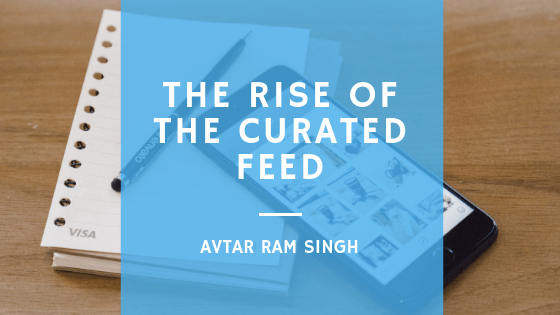
By Avtar Ram Singh, {grow} Contributing Columnist
Back in the early 2000s, I was incredibly active on various… forums. Remember them? Those community-centric conversation portals hosted on platforms like phpBB, vBulletin and ProBoards, where the ads were hidden away at the bottom or on the top in the form of banners. Back then, and this might shock you, people couldn’t find a Quora result for a very specific tech problem, and went to forums like Neowin to find an answer, or ask a question.
Simpler times.
The rise of social networks, and then groups within social networks was a pretty big blow to forums. People just couldn’t be bothered to maintain multiple accounts across different websites when they could simply join a Facebook group and have all the conversations they needed to on the same platform, or app. The rise of Facebook, and by extension the rise of social logins, has de-prioritised online anonymity for the masses.
The Personal Newsfeed
Few would argue against the point that the newsfeed is one of the most ground-breaking features that has ever been introduced by social networks. For Facebook, Twitter and Instagram – it’s the primary money-making tool, the place for discovery, to spread ideas, space that brands covet being in, and the evolution of which has been heavily discussed, debated and criticised.
The newsfeed is the first thing we see when we log onto a network like LinkedIn. It’s the heartbeat of a social network, the starting point from where people see what’s happening in the lives of their friends, and a way to stay in touch with family in different places.
Except lately… it hasn’t been.
There are two key reasons that the newsfeed has evolved into something beyond what the initial intended vision was.
- The first, is that the way in which people use social networks has changed. From a place where you shared pictures of your trips, family and every day moments, it has morphed into a network of political discourse, and heated debates on ethics, values and life. It can be taxing.
- The second, is that in order for the newsfeed to succeed as a business, networks have focused on monetising it, and in trying to drum up the value of “appearing in the feed”, have managed to get brands to drop millions each year to surface poor content in the feed, and inspired social pages to create content to “game the feed”.
Both of these shifts in tech culture fundamentally changed the nature of the newsfeed.
The State of the Newsfeed
The so-called demise of the newsfeed has perhaps been slightly exaggerated, but it cannot be wholly denied. There are articles that talk about de-cluttering your newsfeed, and reputable blogs that straight-up call it a complete mess.
There are many reasons why people feel the newsfeed has faltered from its utopian vision, but in my mind, here are the key problems with most social newsfeeds:
- There’s far too much third-party content surfaced in in the newsfeed (shared articles, videos from other pages) rather than personal content, which makes a personal newsfeed feel like a very impersonal experience.
- Facebook Pages that “game” the newsfeed show up over and over, for example content that asks you to “like” or “comment” on the post as a showcase of your ethical, moral or religious beliefs.
- The incredible increase in the advertising you see in your newsfeed. An ad after every 4-5 posts was okay, but the Facebook mid-roll can really get on your nerves.
- Poor management of spam, click-bait and fake content that is widely circulated.
… and so many more. Those are some personal gripes that I have with the feed, but I’ve heard many people complain about a lot more. Algorithms that dictate what to showcase in your feed, supposedly based on what you interact with or are interested in are seemingly failing. So it’s not a surprise that we’re seeing… the rise of the curated newsfeed.
The Curated Newsfeed
If it isn’t apparent enough, I’ve barely been spending time in my social newsfeed these days. I go through Twitter on a regular basis, but on other networks I barely bother. There’s just too much clutter to sift through, and I’d hate to feel like I don’t want to open the network completely.
Over the last couple of months, something interesting has been happening. This is part a personal anecdote and part a shift that the world is seeing. I’ll start with the personal anecdote.
Organically, a few friends of mine created a couple of groups on Facebook Messenger, WhatsApp and on Instagram. The Facebook Messenger group wasn’t meant to be anything more than a few football buddies and I to stay in touch about upcoming games we’re playing in, and find out who’s on the way, has reached the field and so on and so forth. Mundane stuff.
But over time, that group has become the focal point of discussion about all things football, transfer news, match results, and heated post-match analysis. I don’t get my dose of “social” football from my newsfeed and from posts people put up, I get it from that Messenger group.
On WhatsApp, there’s a small group that a few ex-colleagues and I formed to stay in touch with each other and organise social gatherings after a few departed the company that brought us together. Over time, that WhatsApp group has turned into (among other things), a platform for us to discuss what’s happening in the marketing industry.
On Instagram, a close friend of mine started a group with a few of us because she saw a piece of content that she thought all of us would like. She shared that one video, someone else shared another the day after, and slowly… that group just became a place for us to share relatable content and of course… memes.
None of this was designed. None of this was truly deliberate. It just organically happened. And as I’ve had conversations with other people about this experience, I’ve realized that this has become the norm in today’s social media and communication landscape.
The reason is simple.
It’s no longer algorithms that seemingly understand us based on what we interact with that are serving us content in these instances. It’s people that truly know us, and understand exactly what we’d like to see. And you can’t beat that.
The Curated Newsfeed, Beyond Personal Connections
In Priya Krishna’s wonderful piece on WhatsApp groups in India for the New York Times, she mentions:
Anil Bandawane, a farmer living outside Pune, India, was fed up with the poor advice he was getting from the government’s national hotline for agricultural queries. Life as a farmer in India can be isolating, and he felt cut off from his peers.
So he started a WhatsApp group called Baliraja (which roughly means “farmer king” in the Marathi language). The group, which allows his fellow farmers across the country to exchange expertise and support on the popular messaging platform, gained so much traction that Mr. Bandawane has created more than a dozen different subgroups for various districts.
She goes on to state:
Before creating their organic advocacy group Anna Arogya, Mr. Naik, 32, and Mr. Prasad, 48, considered starting a Facebook group or a website instead. But Mr. Naik, the director of a sustainable agriculture organization called Sahaja Samrudha, said he found Facebook to be riddled with advertisements and hard to navigate; creating a website would have required hiring developers and designers — and many in the WhatsApp group don’t even have a computer.
What about Instagram, the favored platform for sharing food information in much of the world? “Putting up Instagram posts is seen as dodgy, since you aren’t knowing how many people are really seeing it,” Ms. Tanya said.
WhatsApp’s wide accessibility allows it to function as a dynamic database for Indians from various generations to record and share their food knowledge — often for the first time.
This is where things get interesting for businesses and marketers.
When focus is deliberately shifting away from “public” spaces into walled private spaces that as of now, are seemingly impenetrable by advertising, where does that leave brands? Make no mistake, even within these groups, people definitely do share content from other websites and videos from brands, but when the ability to track that and monetise that goes out the window, where does that leave brands and marketers?
The Potential Implications
In my mind, this has some key implications:
- The level of engagement directly on brand pages on social networks and properties will likely diminish. Sure, some people will continue to engage, but most will take the conversation into their private groups.
- Heavily “gamed” social content will soon lose relevance, as people seek out quality content that adds some value to them that they’d like to be associated with when they share it with their friends and associates.
- It’ll become harder to track and measure performance of social and digital content, and understand where specifically your audience is coming from. This might lead to a level of discomfort for marketers, but we’re going to learn to have to live with some ambiguity.
- On the business side, social networks will decide to capitalise on the importance of private groups and will likely infiltrate them with some level of advertising. Facebook Messenger and Facebook groups will be easy, and will likely not receive much blowback (and be heavily priced) but Instagram DMs and WhatsApp groups will hopefully be harder to infiltrate.
All things considered however, the more your content is shared in personal groups, the prouder you should feel. Don’t feel frustrated as a marketer if you don’t understand where your traffic is coming from and if you can’t peg back conversions to a specific piece of content.
For someone to find value in your content, and attach their name to it and share it in a private group should be considered quite a feat. The key however, is to spend more time in the construction of that content and making it valuable, rather than worrying about it featuring in private groups.
Control what you can.
 Avtar Ram Singh is the Head of Strategy at FALCON Agency, a performance-led, business results oriented marketing agency that operates in South East Asia. He’s built marketing strategies and performance frameworks for brands on global and regional levels, across a variety of industries. You can find him on LinkedIn, and Twitter.
Avtar Ram Singh is the Head of Strategy at FALCON Agency, a performance-led, business results oriented marketing agency that operates in South East Asia. He’s built marketing strategies and performance frameworks for brands on global and regional levels, across a variety of industries. You can find him on LinkedIn, and Twitter.


